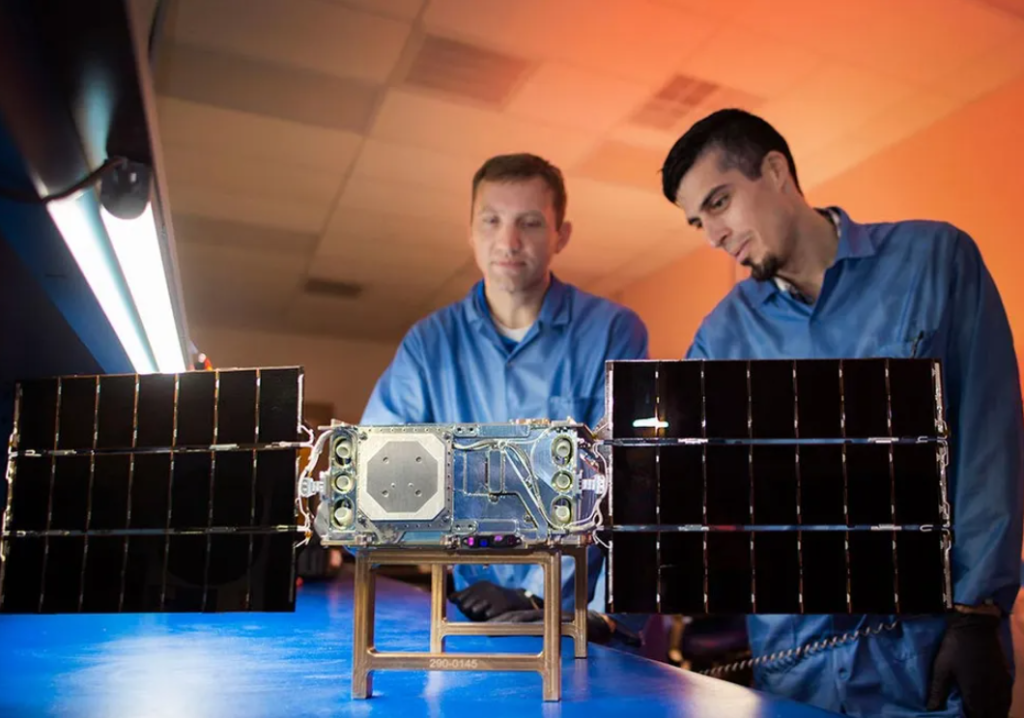It may sound science fantasy to build a 6-mile-wide (10-kilometer-wide) telescope in space. However, NASA’s SunRISE will be a massive radio telescope in orbit that will aid in improving scientists’ understanding of explosive space weather events thanks to the combined power of six toaster-sized satellites. In addition to endangering personnel and technology in space, these events also pose a threat to communications and electrical networks on Earth. The first of those tiny satellites, called SunRISE—short for Sun Radio Interferometer Space Experiment—has already been finished in advance of its anticipated launch in 2024. It was constructed by Utah State University’s Space Dynamics Laboratory (SDL), which has a contract with NASA to develop, test, and launch all six satellites.
Jim Lux, project manager for SunRISE at NASA’s Jet Propulsion Laboratory in Southern California, stated, “It’s incredibly thrilling to see the space vehicles coming together.” These satellites will eventually combine to build a massive space telescope that will allow for observations of the Sun that are not achievable from the surface of the Earth.

The SmallSats will each function as a single antenna to pick up radio wave bursts coming from the corona, the Sun’s superheated atmosphere. Each has four telescoping antenna booms that each extend to a length of roughly 10 feet (2.5 metres), forming a “X.” They will swarm together to form one enormous virtual radio telescope as they orbit Earth from a distance of around 22,000 miles (36,000 kilometres).
Scientists will employ the method of interferometry to build a large-aperture radio telescope as wide as the separation between the SmallSats that are closest together, or roughly 6 miles, when NASA’s Deep Space Network receives the signals from all six SmallSats (10 kilometers).
Interferometry is frequently used by ground-based radio telescopes, including the renowned Karl G. Jansky Very Large Array in New Mexico, to combine the viewing power of numerous individual antennas. SunRISE will have one distinct advantage over its ground-based counterparts, though: It will be able to “see” the long radio wavelengths that are obstructed by the ionosphere, a portion of our planet’s upper atmosphere. Because of this, SunRISE will pinpoint where solar radio bursts, or sudden event-type emissions of radio waves, erupt higher up in the Sun’s corona. Then the SunRISE team can create detailed maps of their positions in 3D.
Hazardous Space Weather
Solar flares and coronal mass ejections are produced when superheated solar particles and strong magnetic fields collide in the corona of the Sun (CMEs). In turn, flares and CMEs can speed up solar energetic particles, which also come from the corona, posing a threat to life on Earth throughout the solar system. The arrival of solar energetic particle events at Earth has been known to be preceded by tens of minutes by solar radio bursts. SunRISE will demonstrate how an early warning of approaching solar energetic particle events might be useful by locating the sites of solar radio bursts. Researchers can also look at how CMEs trigger radio bursts if they can identify regions of particle acceleration by observing solar radio bursts in relation to where CMEs occur. As the radio bursts are produced along them, SunRISE will trace the pattern of the solar magnetic field lines that extend far into interplanetary space in addition to providing 3D photos. The telescope will also be constantly scanning the Sun for radio bursts that might suddenly appear anywhere in the corona.
According to Justin Kasper, SunRISE principle investigator at the University of Michigan in Ann Arbor, “the mission’s ultimate purpose is to assist scientists better understand the mechanics underlying these catastrophic space weather events.” These very energetic solar particles pose a threat to electronics and exposed astronauts. We can better prepare for these events by monitoring the radio bursts connected with them.
The observations from the mission will be combined with information from other space missions and ground-based observatories. For instance, SunRISE may capture images of solar radio bursts while NASA’s Parker Solar Probe flies by them, giving researchers a chance to examine the acceleration of the sun’s explosive particles. And by combining SunRISE data with observations made by the NASA-ESA Solar and Heliospheric Observatory (SOHO), scientists will be able to determine how and where CMEs can trigger different types of radio bursts as they travel from the Sun, and how many of the accelerated particles arrive in Earth’s vicinity.
More About the Mission
SunRISE is a Mission of Opportunity for NASA’s Explorers Program Office’s Heliophysics Division. The Explorers Program, the longest-running NASA programme, was created to offer frequent, affordable access to space through principal investigator-led space science investigations relevant to the Science Mission Directorate’s (SMD) astrophysics and heliophysics programmes. Missions of Opportunity are a part of the Explorers Program. The Goddard Space Flight Center in Greenbelt, Maryland, administers the programme on behalf of SMD. SunRISE is maintained by the Jet Propulsion Laboratory (JPL), a part of Caltech in Pasadena, California, and is led by the University of Michigan in Ann Arbor.
You may like to read:
On the road to cleaner, greener, and faster driving – with some help from AI












